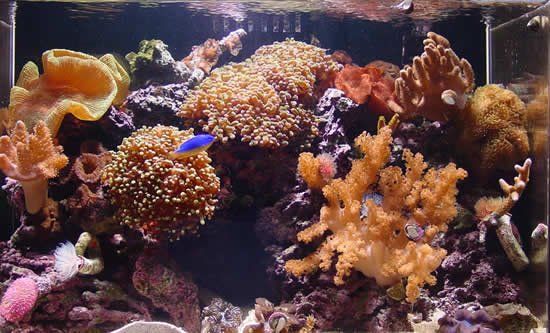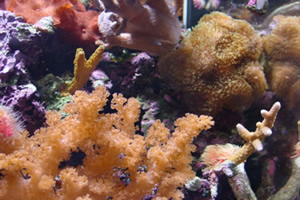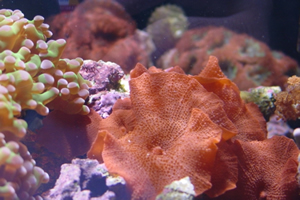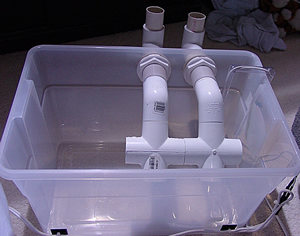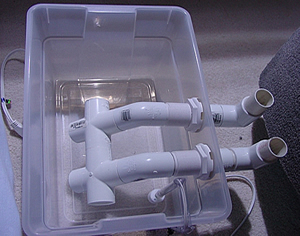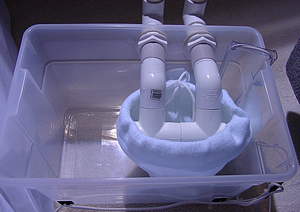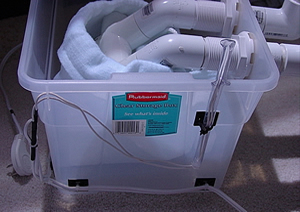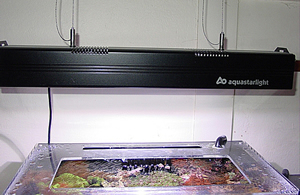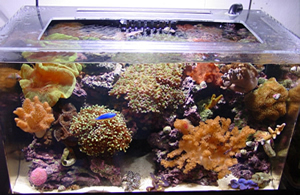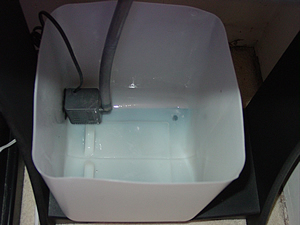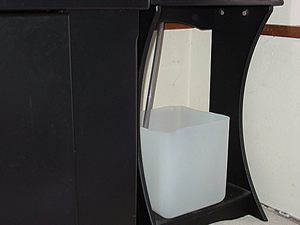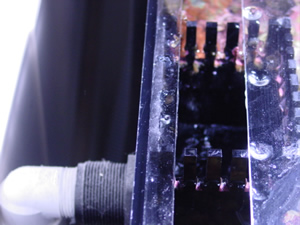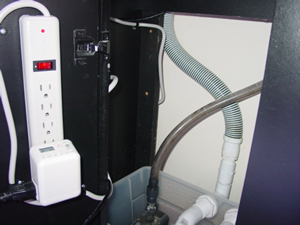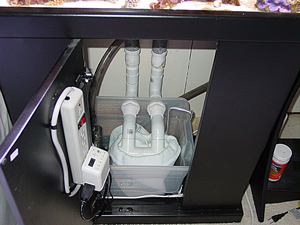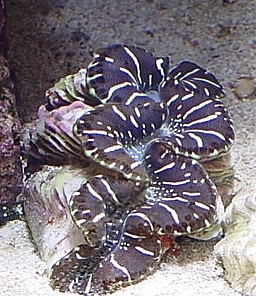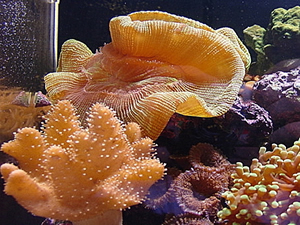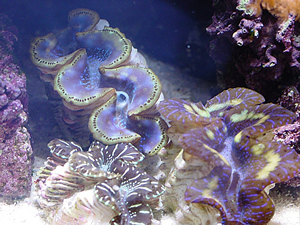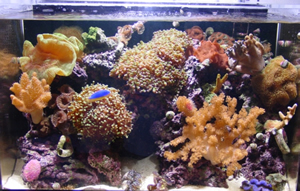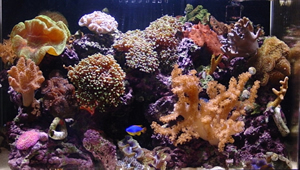
|
|
|
Cameron Coe's
(Physh1) 20 Gallon Reef Tank
I have worked at local fish stores
since I was 14, and now that I am soon to be 23, I have
been involved with this hobby for quite a while. Despite
having years of keeping tanks under my belt, there came
a time when I really didn't care to keep one anymore. The
idea of working forty plus hours a week, and then coming
home each night to fiddle with my aquarium wasn't an attractive
endeavor. However, seeing all the new incredible critters
and corals coming into the store on a daily basis isn't
the best thing to see when trying to avoid setting up another
aquarium. The day soon came when I couldn't take it anymore
and I had to set one up. My main concerns were size and
cost; I wanted both to be small and not occupy all my spare
time.
The Tank and Stand The aquarium is a simple TruVu acrylic 20 gallon aquarium, with no options other than a black back. I wanted to keep this clean and simple. The aquarium is sitting on a 30" black stand, made by Island, which has a lip for the aquarium to sit in. I wanted to have an overflow on this aquarium, and definitely didn't care for an unreliable hang-on overflow or a huge corner unit that takes up too much space. I installed a 6" x 4" x 6" black homemade overflow box in the center back wall of the tank. The box was glued to the inside of the tank with silicone and allowed to dry. Then, I drilled a 1 ½ inch hole through the back wall of the tank and the overflow chamber to accept a 1 inch bulkhead fitting.
Sump Plumbing and Tank Circulation The first stage of the plumbing started with the homemade overflow and bulkhead setup mentioned above. From there a three foot long pool style hose (1" end fittings) connected the overflow to a simple 5 gallon Rubbermaid sump. The only mechanical filtration is a micron bag, which also serves as a bubble trap for the water draining into the sump. It does a good job of containing the air bubbles and also keeps big particulates from clogging the pumps. I replace the micron filter bag approximately every 8 weeks. The sump also contains a Second Nature 100 watt Acura heater and a Rio 2500 return pump. The return pump is unrestricted and flows back to the aquarium through ¾" vinyl hose. A Marineland return fitting (part# pr1401) safely returns the water to the main tank. This supplies the ONLY circulation for the aquarium. I have found no need to add any additional circulation in the tank, as I have taken the time to place the corals in areas where they receive the required flow regime to prosper.
Lighting Description I decided that lighting is the one item where spending a goodly amount of money was definitely worth the added expense. I feel pretty strongly about the importance of proper lighting and have found that things like filtration and circulation can vary from a simplistic to an elaborate setup, yet still be successful. With lighting there is only one really good way to come close to duplicating sunlight, and that is with some form of metal halide lighting. Both HQI and mogul base systems are available, and the HQI system was compact enough to work on my tank. I chose to run a 150 watt 10,000K system made by AquaMedic, called the AquaStarLight. I run the halide on a 6 hour photoperiod (4pm to 10pm). This light hood contains just the metal halide with no actinic supplement. The hood hangs from my ceiling, using the hanger hardware supplied with the hood, and is suspended 10" above the aquarium.
Evaporation Make-up System One problem small tanks have is
evaporation. That was the first problem that I wanted to
avoid when I set up this system. So, I made my own float
switch, visible on the sump photos, that was hooked to a
Rio 800 pump. The Rio sits in a 5 gallon jug that pumps
the water into the overflow box in the tank. I did this
so the new freshwater would be well mixed, thereby avoiding
any un-necessary stress on the inhabitants from the new
water being placed into the system. The float switch is
sensitive to approximately 1/3 of an inch, so it keeps the
salinity from fluctuating too much. This tank goes through
about 4 gallons of makeup water in a week's time. Deionized
water, available from the local fish store where I work,
is used exclusively.
Maintenance This tank receives very little maintenance.
The tank stays amazingly clear of any algae and may receive
a wipe of the glass once every 2-3 months. A 5 gallon water
change is done on a monthly basis. I use de-ionized water
with Coralife salt for the water changes. The micron bag
in the sump used for a bubble trap is changed or cleaned
every 2 months. The Rio 2500 return pump is pulled out and
cleaned every 3-4 months.
Additives, Dosing, and Feedings It is hard to find a good mix of chemicals that is both simple to add and effective at the same time. For the necessary calcium and alkalinity dosing, I use Seachem Reef Advantage Calcium and Reef Builder. Seachems' Reef Advantage Magnesium is used to keep my calcium and alkalinity levels stable. I use Kent Lugols' Solution for an Iodine supplement and Ecosystem Aquarium Reef Solution for the other minor and major elements. DT's Phytoplankton is added to the aquarium for the corals and clams to feed on; I have noticed a greater ability to keep SPS and clams with its frequent addition. The mushrooms and soft corals also have gotten so much larger, that I have begun to fragment many of them. The fish are fed OSI marine flake
food and an occasional feeding of live brine shrimp (cleaned
first).
Conclusion I hope I have helped show that
tanks may be small and very successful without much work.
As of right now I cannot see myself adding anything else,
as there is no room. Actually, as far as I am concerned
the tank is perfect for me, and I will let it grow. This
tank is only 16 months old. I can only wish my luck continues.
I have found that with the proper selection of inhabitants
a tank can live off itself, to a point, without lots of
outside "interference." Clams are a great natural
water filter, and I believe that they have made my filterless
system a success, especially when it comes to nitrate reduction
and control. I hope you have enjoyed my tank and feel free
to stop by the Tank of the Month forum for any further explanations
or discussions.
If there are questions, I will do my best to answer them in the forum for the online magazine.
|


